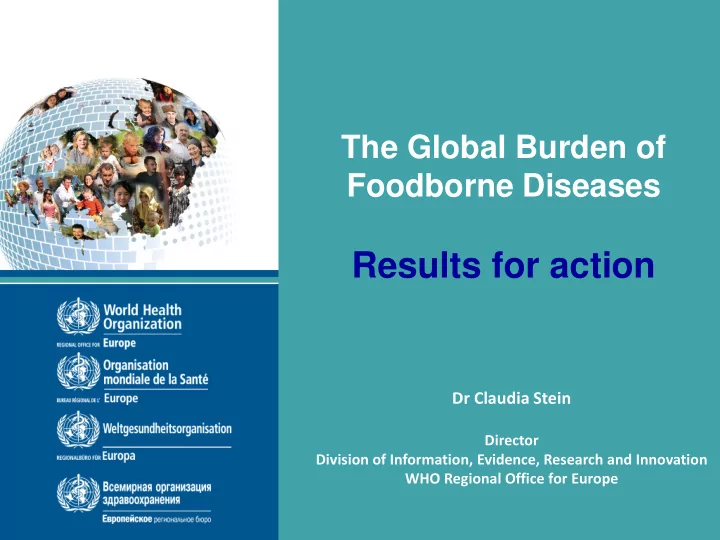

The Global Burden of Foodborne Diseases Results for action Dr Claudia Stein Director Division of Information, Evidence, Research and Innovation WHO Regional Office for Europe
…and the under- and un-reported Food: The good, the bad and the misreported – Why we needed to estimate the burden of foodborne diseases
What are "Foodborne Diseases"? • Diseases transmitted through the ingestion of contaminated food • Caused by bacteria, viruses, parasites, prions and chemicals/toxins (inc ncl. al . aller ergens) • …and they are everywhere
Reporting on foodborne diseases and food safety: Exploding the myths
Myth No 1: 'Foodborne diseases are mostly a problem of developing countries' USA: 76 million cases of foodborne illness from pathogens alone each year (Mead et al, Emerg Infec Dis, 1999)
Myth No 2: 'Foodborne diseases in rich countries are mostly travel-related' United States and EU: In most countries majority of cases is domestically acquired (CDC & European Food Standards Agency)
Myth No 3 – the convenient one: 'It's imported foods from poor countries (aka 'poor hygiene') that cause our foodborne diseases' Rich countries have exported new foodborne diseases to poor countries: Salmonella enteritidis Salmonella typhimurium Dioxin BSE
Myth No 4: 'Foodborne diseases are getting less & less frequent' 335 newly emerging infectious diseases: • 95 pathogens transmitted through food (~30%) • 50 (15%) due to "changes in agricultural or food industry" • many resistant to antibiotics Compounded by effects of climate change
Myth No 5: 'Foodborne diseases are mild, self-limited and short' Campylobacter: Guillain Barré Syndrome Reactive arthritis Guillai ain B n Barré é Syndr ndrom ome Salmonella spp: Reactive arthritis Septicaemia USA: Meningitis 2.2 million deaths Listeria: Meningitis 5,000 deaths Septicaemia from diarrhoeal diseases from foodborne illness Perinatal loss E.coli: Renal failure each year world-wide from pathogens alone Pork tapeworm: Epilepsy each year Toxoplasma: Retinopathy (World Health Organization, 2008) Trichinella: Multi-organ failure (Mead et al, Emerg Infec Dis, 1999) Acrylamide: Cancer Arsenic: Cancer Aflatoxin: Cancer Lead: Mental retardation Dioxins: Cancer Allergens: Anaphylactic shock
Myth No 6 – the hopeful one: ' As a vegetarian I am less likely to get foodborne diseases'
Myth No 7 – the easy one: 'Governments hold the sole responsibility for making food safer' Vehicle emission Crops Processing Agricultural practices Retail Cooking Livestock Sewage Storage Seafood Industrial emissions and effluents Distribution
Myth No 8 – the dangerous one: 'Food security is more important than food safety' Food security without food safety can cause • Malnourished people are more great harm vulnerable to foodborne diseases & more likely to die • Contaminated food is rarely discarded in famine situations
Myth No 9 – the big one: ' Our food is perfectly safe'
How big is the burden of foodborne diseases? Reported human cases Reported human cases What we know from surveillance data What we need to know Actual human disease burden
Myth No 10 – the understandable one: 'We can never estimate the burden of foodborne diseases' Yes, , we we can. an. And nd we we have. hav e.
Pictur ures es aw awai aited: ed: Dr J Joh ohn C n C Lar arssen en "What hat does esn't n't get Dr J Jos osef ef Schl hlat atter meas asur ured, ed, does esn't n't Prof of Rol olaf af van n Le Leeuw euwen en get get don done" "How ow el else to o as assess effectiveness of food saf afety pol policies & inter ervent entions ons?" ?" Establ ablish h Foodbor odborne ne Diseas ease e Burden den Epidem demiol ology ogy Refer erenc ence e Group oup (FERG)
WHO Initiative to Estimate the Global Burden of Foodborne Diseases • Why? – Because information on burden of FBD from all causes is poor – Policy makers require information to assess effectiveness of prevention and interventions (incl. Codex) – Foster international development and global health security • What? – Estimation of morbidity, disability and mortality of FBD – Development of tools for countries to conduct BoD studies • Outcome – Global and regional report – Country Burden of Disease studies
Wha hat is the he % foodb dbor orne? ne? Bur urden den of diseas ease
Thank hank you you Mea eat han hanging out out to o dr dry, Cambo bodi dia a
Extra slides
Interpretation of DALYs No o death deaths x yrs los ost agai t against s t stan tandard Incidenc dence x e x duration x on x DW DALY = YLL + YLD High number deaths High incidence Young adult deaths Sequela +++ High DW High LE assumed Long duration
Recommend
More recommend